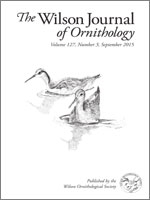The Rufous-backed Robin (Turdus rufopalliatus) is a bird endemic to the Pacific slope of Mexico and the Balsas Basin, and is currently expanding its distribution range to the Mexican Central Highlands, occupying urban areas. Its breeding biology is poorly known in its original distribution range and unknown in the newly colonized areas. We present a description of its breeding biology in one of the newly colonized areas, including nest site selection, nest composition, clutch size, eggs and incubation period, hatching and nestling success, and observations on behavior of adults and nestlings. The study was conducted in 2013 in an urban area of central Mexico, specifically at the main campus of Universidad Autónoma del Estado de Hidalgo, in Pachuca, Hidalgo. Nests were built on trees at a mean height of 5.66 ± 0.51 m. The nest was generally a shallow cup made of vegetable material reinforced with mud. Mean clutch size was 2.75 ± 0.16. Eggs were light to medium blue with reddish-brown markings. Incubation period lasted around 13 days. Hatching success was on average 1.88 ± 0.35. Nestlings remained 14 days in the nest before they fledged. The nests, eggs, and behavior have some characteristics similar to those of other thrushes, including individuals of the same species in their original distribution range. We discuss the implications of including anthropogenic materials in nest construction and present the first case of fledgling entanglement with synthetic materials at the nest for T. rufopalliatus.
How to translate text using browser tools
1 September 2015
Breeding Biology of the Rufous-backed Robin (Turdus rufopalliatus) in an Urban Area Outside its Original Distribution Range
Pilar Carbó-Ramírez,
Rodrigo A. González-Arrieta,
Iriana Zuria
ACCESS THE FULL ARTICLE
nest composition
nest entanglement
range expansion
Turdidae
urbanization





